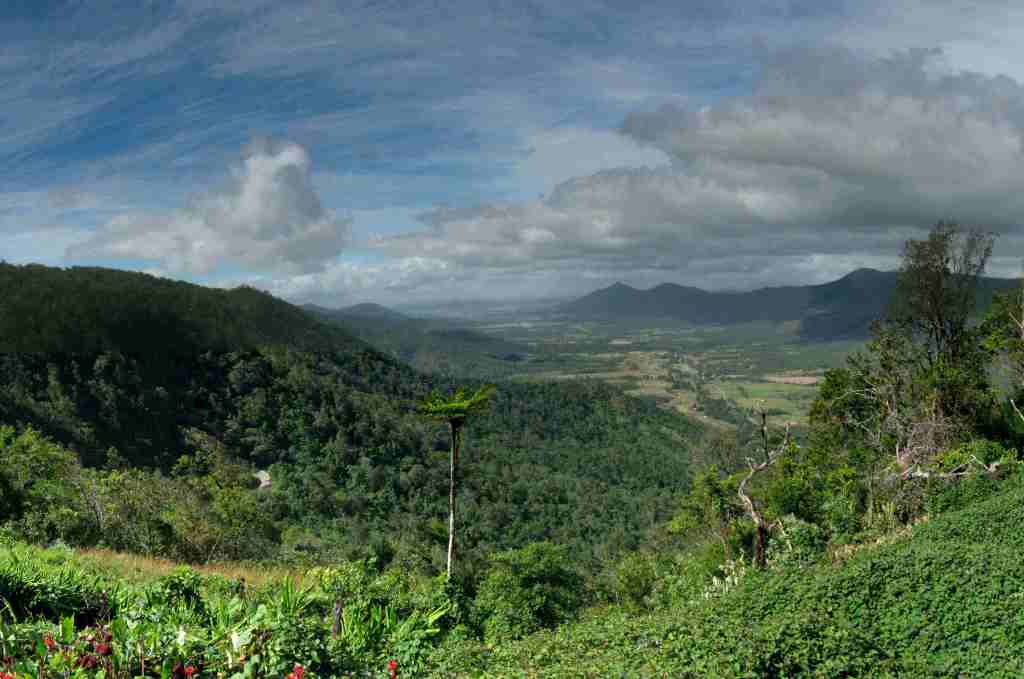Caught in a cold snap that has dropped minimum temperatures as low as 16°C during the past two weeks, Townsville brooded under heavy cloud while I ran in the Ross River Parkway this morning. A cool breeze totally at odds with the still, sultry heat of late December made exercising a pleasure rather than the sweat-drenched chore of four and half months ago. Perhaps we’ve truly rounded the corner and can now glance back over our shoulders to see the staggering heat of summer finally waning in the distance behind us.
During the evening, Vilis, Janis, and I attended one of a series of Queensland history lectures offered by Townsville City Libraries at its Thuringowa branch. Tonight’s lecture, presented by Dr. Allison Craven of James Cook University’s School of Arts and Social Sciences, was titled ‘Fencelines and Horizon Lines: Queensland in the Imaginary Geographies of Cinema.’
Although presented at a machine-gun pace, I did manage to snag a few of the lecture’s major concepts as they blew past me. The first of these was that the history of film in Queensland could be described as several distinct eras. The second was that the Queensland landscape played a major role in defining many of these films, even though no reference may have been made in the film to Queensland. A third major point emphasized that films created in Queensland repeatedly presented utopian views; that is, “not only bodies, but towns and regions are dressed to repeat heritage,” but heritage does not equal historical fact.
The history of film-making in Queensland dates back to 1895, with the first era of cinema spanning 1895-1910. Queensland’s first film was shot using a cinématographe – a new invention by the French Lumiére brothers that not only recorded film images, but also developed and projected them.1 In 1899, Frederick Charles Wills used a hand-cranked Lumiére cinématographe to create 80 single-minute films of diverse topics – such as sheep dipping or Queensland troops departing for the Boer War – and submitted them to the Greater Britain Exhibition 1899 (world fair) held in London. Also during this first stage of film development in Queensland, the Salvation Army or Salvo’s employed Sidney Cook, who in addition to creating short films for Salvo’s travelling presentations, also made the first film documenting sheep shearing, as well as one of the port of Brisbane.
By the 1920’s, most of the films screened in Queensland came from Hollywood, creating a second era of film history wherein Queensland films took a back seat to American films.
During the 1940’s, a couple of notable films centred on the concept of heroic humans battling the Queensland bush. The first of these was Sister Kenny, a ‘biopic,’ in Dr. Craven’s words, which portrayed the life of bush nurse Elizabeth Kenny. Although set in Queensland, that film was a Hollywood production. Sons of Matthew was one of a series of Queensland epics that, again, painted a picture of the human character set against the wilds of Queensland. A clip from the film showed a half dozen or so young men skinny-dipping in a rainforest pool, the scene complete with vines for swinging out over the water.
Following World War II, Queensland’s film industry largely faded, creating something of a void until the 1970’s, when it was reborn.
The most recent and ongoing era in Queensland film is marked by stronger financial support for state film production and by the incorporation of Queensland landscapes – sometimes depicting paradise; at other times, anti-paradise – in critically-acclaimed films. This era gave rise to The Irishman (1978), a nostalgic portrayal of teamster Paddy Doolan and his sons in the Queensland Gulf Country, and to Traveling North (1987), in which North Queensland is depicted as a natural paradise. Radiance (1998), winner of the Australian Film Institute’s best film award, depicts a trio of indigenous sisters dealing with their mother’s death against a harsh backdrop of sugarcane fields and scrubby bush. More recently, The Proposition (2005) is a kangaroo western that uses fences and horizons to separate civilization from the savagery of land and people. ‘Kangaroo westerns,’ as Dr. Craven described, focus on the time of Australian colonization by Europeans and incorporate themes of racial discrimination and disputed land. Queensland landscape near Bowen was featured in Australia (2009), the epic tale of cattle drovers, romance, the Stolen Generations, and the World War II invasion of Darwin by Japan. This year, Beneath Hill 60 – the World War I tension-filled story of Aussie miners working underground to blow up a strategic German position – has made a big splash, and the movie, which was filmed in Townsville and features the North Queensland landscape in a minor role, is now being shopped at the Cannes Film Festival.
In all these feature films, the Queensland landscape – those fencelines and horizons of the lecture’s title – became the imagined face of this state, and in the broader context, of Australia, both to Australians and to the world.

Pioneer Valley, Queensland
Reference:
1. Wikipedia. Cinematograph. Updated 16-May-2010. Accessed 18-May-2010. http://en.wikipedia.org/wiki/Cinematograph


